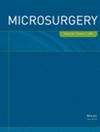The Use of Pedicular Arteriovenous Fistula (PAVF) in Microvascular Reconstruction to Enhance Flow Across the Microvascular Anastomoses
Abstract
Background
Free flap success rates have improved dramatically over the past three decades, setting a high standard for microvascular reconstruction. However, rates of arterial or venous thrombosis, and subsequent failure, remain high in burn and trauma reconstruction when compared to autologous breast reconstruction and other elective flaps. To address the higher failure rate, we use a novel vascular approach. We create a pedicular arteriovenous fistula (PAVF), allowing the flow to be enhanced across the microvascular anastomoses.
Methods
We performed a retrospective review of 13 consecutive patients with 14 free flaps who underwent PAVF creation by the first author, AO. All patients who required free tissue transfer for trauma and burn reconstruction were indicated for PAVF during this study period. The flaps in this study included ALT, fibula, parascapular, and partial latissimus. The perforator and pedicle for the flaps were dissected in the usual manner. Distal to the takeoff of the perforator to the flap, the pedicular artery and the larger of the accompanying veins were anastomosed to create the PAVF.
Results
Patients were followed for a mean of 171 days Thrombosis was a rare complication in the group with one venous thrombosis (n = 1, 7.14%) and no arterial thrombosis. The most common complication was return to the operating room n = 4 (28.57%), two of which secondary to hematomas (14.29%), one wound dehiscence and one venous thrombosis. This latter patient eventually had partial flap loss.
Discussion
We did not observe flap ischemia due to vascular steal, nor any venous congestion from pressurizing the venous outflow. As opposed to anticoagulation, flow enhancement aims to decrease the risk of thrombosis by reducing stasis. While further data is needed to compare the outcomes of venous enhanced flaps when compared to flaps treated prophylactically with anticoagulation, our initial data suggests that PAVF is a safe procedure and does not result in vascular steal or flap congestion.

 求助内容:
求助内容: 应助结果提醒方式:
应助结果提醒方式:


